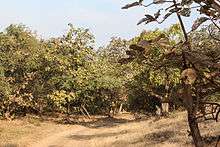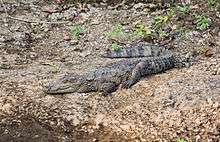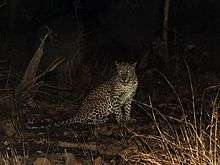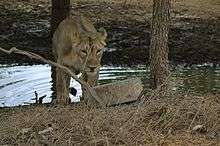Gir National Park
Gir National Park and Wildlife Sanctuary, also known as Sasan Gir, is a forest and wildlife sanctuary near Talala Gir in Gujarat, India. It is located 43 km (27 mi) north-east of Somnath, 65 km (40 mi) south-east of Junagadh and 60 km (37 mi) south-west of Amreli. It was established in 1965, with a total area of 1,412 km2 (545 sq mi), of which 258 km2 (100 sq mi) is fully protected as national park and 1,153 km2 (445 sq mi) as wildlife sanctuary.[1] It is part of the Kathiawar-Gir dry deciduous forests ecoregion.[2][3]
| Gir National Park | |
|---|---|
IUCN category II (national park) | |
 Family of Asiatic lions at Gir National Park | |
 Location map | |
| Location | Junagadh, Gir Somnath and Amreli Districts, Gujarat, India |
| Nearest city | Talala (Gir) |
| Coordinates | 21°08′08″N 70°47′48″E |
| Area | 1,412 km2 (545 sq mi) |
| Established | 1965 |
| Visitors | 60,148 (in 2004) |
| Governing body | Forests & Environment Department |
The 14th Asiatic Lion Census 2015 was conducted in May 2015. In 2015, the population was 523 (27% up compared to previous census in 2010). The population was 411 in 2010 and 359 in 2005. The lion population in Junagadh District was 268 individuals, 44 in Gir Somnath District, 174 in Amreli District , and 37 in Bhavangar District. There are 109 males, 201 females and 213 cubs.[4]
Gir National Park is closed from 16 June to 15 October every year. The best time to visit it is between December and March. Although it is very hot in April and May, these are the best months for wildlife viewing and photography. [5]
History
In the 19th century, the rulers of Indian princely states used to invite the British colonists for hunting expeditions. At the end of the 19th century, only about a dozen Asiatic lions were left in India, all of them in the Gir Forest, which was part of the Nawab of Junagarh's private hunting grounds. British viceroys brought the drastic decline of the lion population in Gir to the attention of the Nawab of Junagadh, who established the sanctuary. Today, it is the only area in Asia where Asiatic lions occur and is considered one of the most important protected areas in Asia because of its biodiversity. The Gir ecosystem with its diverse flora and fauna is protected as a result of the efforts of the government forest department, wildlife activists and NGOs. It is now considered the jewel of Gujarat's ecological resources.[6]
Geography

Water reserves

The seven major perennial rivers of the Gir region are Hiran, Shetrunji, Datardi, Shingoda, Machhundri, Godavari and Raval. The four reservoirs of the area are at four dams, one each on Hiran, Machhundri, Raval and Shingoda rivers, including the biggest reservoir in the area, the Kamleshwar Dam, dubbed 'the lifeline of Gir'. It is located at 21°08′08″N 70°47′48″E.
During peak summer, surface water for wild animals is available at about 300 water points. When drought hits the area following a poor rainfall, surface water is not available at a majority of these points, and water scarcity becomes a serious problem (mainly in the eastern part of the sanctuary). Ensuring the availability of water during peak summer is one of the major tasks of the Forest Department staff.
Flora


More than 400 plant species were recorded in the survey of Gir forest by Samtapau & Raizada in 1955. The Botany department of M.S. University of Baroda has revised the count to 507 during their survey. According to the 1964 forest type classification by Champion & Sheth, the Gir forest falls under "5A/C-1a—very dry teak forest" classification. Teak occurs mixed with dry deciduous species. The degradation stages (DS) sub-types are thus derived as:
- 5/DS1-Dry deciduous scrub forest and
- 5/DS1-Dry savannah forests (Locally known as "vidis"). It is the largest dry deciduous forest in western India.[1]
Teak bearing areas are mainly in the eastern portion of the forest, which constitutes nearly half of the total area. Several species of acacia are found. Also found here are ber, jamun(Syzygium cumini), babul(acacia), flame of the forest, zizyphus, tendu and dhak. Also plants like karanj, umlo, amli, sirus, kalam, charal and an occasional vad or banyan tree are found. These broadleaf trees provide a cool shade and moisture content to the region. As part of the afforestation programme casuarina and prosopis have been planted along the coast borders of gir.
The forest is an important biological research area with considerable scientific, educational, aesthetic and recreational values. It provides nearly 5 million kilograms of green grass by annual harvesting, which is valued approximately at Rs. 500 million (US$7.12 million). The forest provides nearly 123,000 metric tons worth of fuel wood annually.
Wildlife


.jpg)
The count of 2,375 distinct fauna species of Gir includes about 38 species of mammals, around 300 species of birds, 37 species of reptiles and more than 2,000 species of insects.[1]
The carnivores group mainly comprises the Asiatic lion, Indian leopard, jungle cat, striped hyena, Golden jackal,[7] Indian gray mongoose and Ruddy mongoose, and honey badger. Desert cats and rusty-spotted cats occur but are rarely seen.[1][6]
The main herbivores of Gir are chital, nilgai, sambar, four-horned antelope, chinkara and wild boar. Blackbucks from the surrounding area are sometimes seen in the sanctuary.[1] Among the smaller mammals, porcupine and hare are common, but the pangolin is rare.[6]
The reptiles are represented by the mugger crocodile,[8] Indian cobra, tortoise and monitor lizard which inhabit the sanctuary's bodies of water. Snakes are found in the bush and forest. Pythons are sighted at times along the stream banks. Gir has been used by the Gujarat State Forest Department which formed the Indian Crocodile Conservation Project in 1977 and released close to 1000 marsh crocodiles into Lake Kamaleshwar and other small bodies of water in and around Gir.
The plentiful avifauna population has more than 300 species of birds, most of which are resident. The scavenger group of birds has 6 recorded species of vultures. Some of the typical species of Gir include crested serpent eagle, endangered Bonelli's eagle, changeable hawk-eagle, brown fish owl, Indian eagle-owl, rock bush-quail, Indian peafowl, brown-capped pygmy woodpecker, black-headed oriole, crested treeswift and Indian pitta. The Indian grey hornbill was not found from the last census of 2001.[1]
Asiatic lion habitat, distribution and population

The Asiatic lion's habitat is dry scrub land and open deciduous forest. The lion population increased from 411 individuals in 2010 to 523 in 2015, and all of them live in or around Gir National Park. The first modern day count of lions was done by Mark Alexander Wynter-Blyth, the principal of Rajkumar College, Rajkot and R.S. Dharmakumarsinhji sometime between 1948 and 1963, probably early in his tenure as the principal during that period. Even though the Gir Forest is well protected, there are instances of Asiatic lions being poached. They have also been poisoned in retaliation for attacking livestock. Some of the other threats include floods, fires and the possibility of epidemics and natural calamities. Gir nonetheless remains the most promising long term preserve for them.
During a prolonged drought from 1899 to 1901, lions attacked livestock and people beyond the Gir Forest. After 1904, the rulers of Junagadh compensated livestock losses. Today, the lions in Gir National Park rarely attack people.[9]
The lion breeding programme and lion-counting
| Year | Count | Male:Female:Cubs |
| 1968 | 177 | - |
| 1974 | 180 | - |
| 1979 | 261 | 76:100:100 |
| 1984 | 252 | 88:100:64 |
| 1990 | 249 | 82:100:67 |
| 1995 | 265 | 94:100:71 |
| 2000 | 327 | 99:115:76 |
| 2005 | 359 | - |
| 2010 | 411 | 97:162:152 |
| 2015 | 523 | 109:201:213 |
The Lion Breeding Programme creates and maintains breeding centres. It also carries out studies of the behaviour of the Asiatic lions and also practices artificial insemination. One such centre has been established in the Sakkarbaug Zoo at the district headquarters of Junagadh, which has successfully bred about 180 lions. 126 pure Asiatic lions have been given to zoos in India and abroad.
The census of lions takes place every five years. Previously indirect methods like using pugmarks of the lion were adopted for the count. However, during the census of April 2005 (which originally was scheduled for 2006, but was advanced following the reports and controversy over vanishing tigers in India), "Block-Direct-Total Count" method was employed with the help of around 1,000 forest officials, experts and volunteers. It means that only those lions were counted that were "spotted" visually. Use of "live bait" (a prey that is alive and used as a bait) for the exercise, though thought to be a traditional practice, was not used this time. The reason believed to be behind this is the Gujarat High Court ruling of 2000 against such a use of animals.
During the 2010 census 'The Cat Women of Gir Forest' counted more than 411 lions in the park, and 523 in 2015. The women who do the counting are of traditional Muslim tribes in neighboring villages. There are over 40 women van raksha sahayaks, who seek only to protect the animals of the park. These women have worked hard to win cooperation not just from local villagers but also from maaldharis, the semi-nomadic tribal herdsmen who live in the sanctuary. While tourist numbers are increasing people do not seem to understand the phenomena taking place. The lions are almost tame in the presence of these female guards.
Gir Interpretation Zone, Devalia
Gir National Park and Sanctuary does not have a designated area for tourists. However, to reduce the tourism hazard to the wildlife and to promote nature education, an Interpretation Zone has been created at Devalia within the sanctuary. Within its chained fences, it covers all habitat types and wildlife of Gir with its feeding-cum-living cages for the carnivores and a double-gate entry system.
See also
- Barda Wildlife Sanctuary
- List of national parks and wildlife sanctuaries of Gujarat, India
- Girnar
- Talala Gir
- Kuno Wildlife Sanctuary, the site for re-introducing and establishing the world's second completely separate population of the wild free ranging Asiatic lions in the neighboring state of Madhya Pradesh
- In-situ conservation
- Wildlife conservation
- Siddi
- Baradiya
- The Lion Queens of India
References
- "Gir National Park & Wildlife Sanctuary". Government of Gujarat. Forests and Environment Department. Archived from the original on 22 November 2015. Retrieved 16 April 2013.
- "Kathiawar-Gir dry deciduous forests". Terrestrial Ecoregions. World Wildlife Fund. Retrieved 29 January 2017.
- Jhala, Y. V.; Gopal, R.; Qureshi, Q., eds. (2008). Status of the Tigers, Co-predators, and Prey in India (PDF). TR 08/001. National Tiger Conservation Authority, Govt. of India, New Delhi; Wildlife Institute of India, Dehradun. Archived from the original (PDF) on 2 June 2013.
- "Asiatic Lion population up from 411 to 523 in five years". deshgujarat.com. 10 May 2015. Retrieved 22 March 2018.
- "India Trotter". India Trotter.
- "National Parks and Sanctuaries: Gir National Park & Wildlife Sanctuary". Wildvistas.com. Retrieved 20 May 2017.
- Alam, M.S., Khan, J.A., Njoroge, C.H., Kumar, S. and Meena, R.L. (2015). "Food preferences of the Golden Jackal Canis aureus in the Gir National Park and Sanctuary, Gujarat, India". Journal of Threatened Taxa (7 (2)): 6927–6933. doi:10.11609/jott.o3954.6927-33.CS1 maint: multiple names: authors list (link)
- Da Silva, A. and Lenin, J. (2010). "Mugger Crocodile Crocodylus palustris, pp. 94–98 in S.C. Manolis and C. Stevenson (eds.) Crocodiles. Status Survey and Conservation Action Plan. 3rd edition, Crocodile Specialist Group: Darwin.
- Rangarajan, M. (2013). "Animals with rich histories: the case of the lions of Gir Forest, Gujarat, India". History and Theory. 52 (4): 109–127.
External links
| Wikimedia Commons has media related to Gir Forest National Park. |
- BirdLife International. "Important Bird Areas factsheet: Gir National Park and Wildlife Sanctuary".
- Finding more space for the Asiatic lion, The Hindu - Opinion
- Frontline: A kingdom too small
- National Geographic: Asia's Last Lions

- Asiatic lion Population and Habitat Viability Assessment
- Asiatic Lion Protection Society (ALPS), Gujarat, India